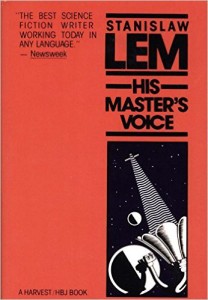Lem, Stanislaw (1968). His Master’s Voice. New York: Harcourt Brace Jovanovich (199 pp.)
It barely counts as a novel, this story presented as a single scientist’s memoir of a project he worked on long ago. There is virtually no dialog, no action, no character development, and almost no plot. Furthermore, the memoir is written at a high level of diction, with a rich vocabulary, including phrases in untranslated Latin. That’s the warning: it’s probably not for the average sci-fi/space opera fan.
The story is somewhat similar to Carl Sagan’s Contact, of the mid-1980s. Lem writes in Polish. HMV appeared in English in 1983; Contact came out in 1985. In both cases, a signal is received on earth, from space, that looks like a communication, and the challenge is to decode the message. In both stories, mathematical transforms are applied to the data and various assumptions are made. In Sagan’s story, the signal turns out to be the plans for a spaceship.
Lem’s story is not so obvious. First, there is the question of whether a recording of neutrino radiation is a signal at all. Maybe it was just an anomaly in ordinary neutron activity. This raises a crucial question: What is a “signal” and how would you recognize one in a SETI project? Is a signal strictly in the mind of the beholder, or would there be something identifiable about a phenomenon that would tell you it was intended as a signal? How do you discriminate signal from noise in the absence of intentionality?
Once you believe you do have a signal, how do you interpret it? It’s not strictly a matter of cryptography because you have no reference criteria. Supposedly, the key to cracking the German Enigma code in WWII was that each message ended with “Heil Hitler!” That constant was enough to develop the solution. You need something to go on.
In Lem’s story, the scientists extract what seems to be a pattern, even though it constitutes only 4% of what they think is the total signal, and they make some earthbound assumptions about what it could mean, and construct a quasi-biological structure from the possible “instructions.” The structure’s purpose is another mystery (It’s not a spaceship).
Lem’s narrator goes on at great length (and tediously, some would say) to question whether or not they were on the right track, knowing absolutely nothing of the alien culture. He gives this example: If you inserted a random computer punch card into a player piano, it could cause sounds to be played, but would it be meaningful to interpret that output, even if you detected a musical phrase?
As the narrator considers one hypothesis after another about what assumptions should and should not be made about the signal, the reader’s mind is whiplashed from side to side and front-to-back. What can you guess about alien epistemology that’s not merely a pathetic projection of unexamined human assumptions? Anything?
And that’s the fun of reading this difficult, wordy, sometimes tedious sci-fi non-novel.

